Regional employment patterns in Scotland: statistics from the Annual Population Survey 2018
Summary publication of results from the Annual Population Survey 2018, presenting analysis on the labour market, education and training.
This document is part of a collection
Section 6: Inactivity
6.1 Inactivity over time
Scotland’s inactivity rate in 2018 was above the rate for the UK.
The inactivity rate for those aged 16-64 in Scotland in 2018 was 22.6 per cent, higher than the UK rate of 21.7 per cent.
Over the year, the rate has remained the same in Scotland while inactivity in the UK decreased by 0.1 percentage points.
Scotland’s inactivity rate is now the same rate as in 2008 (while in the UK the inactivity rate is 1.8 percentage points lower.
Chart 35: Economic Inactivity Rate (16-64), Scotland and UK
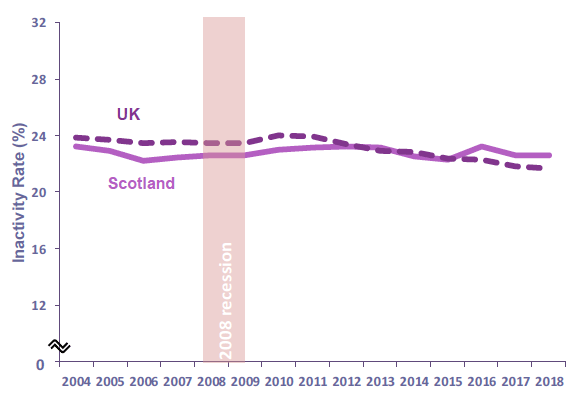
Who is classed as economically inactive?
Individuals aged 16-64 who are neither employed nor unemployed under ILO definitions. There are many reasons why people may be inactive and not considered an active part of the labour supply: they may have a long-term illness or disability, be studying for a qualification, staying at home to look after their family, or have retired.
Inactivity rate is higher for women (16-64 years) at 26.7 per cent compared with 18.2 per cent for men. Overall women account for 60.6 per cent of economically inactive (aged 16-64 years.)
Chart 36: Economic Inactivity Rate (16-64) by Gender, Scotland
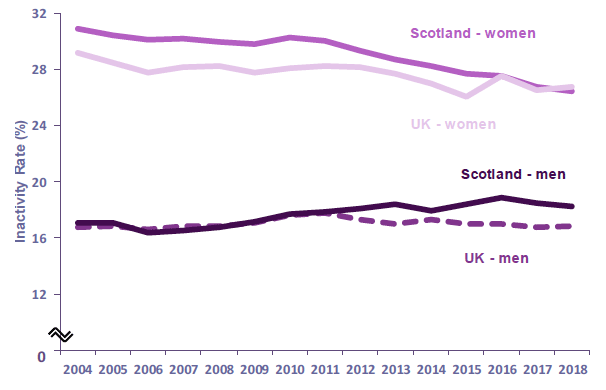
6.2 Gender and age
Since 2008 while the inactivity rate has decreased for women in Scotland, it has increased for men.
The inactivity (16-64) rate for women in Scotland increased by 0.2 percentage point from 26.5 per cent in 2017 to 26.7 per cent in 2018.
Over the same period the inactivity rate for men decreased by 0.2 percentage points (18.4 per cent to 18.2 per cent).
Chart 37: Economic Inactivity Rate (16-64) by Gender
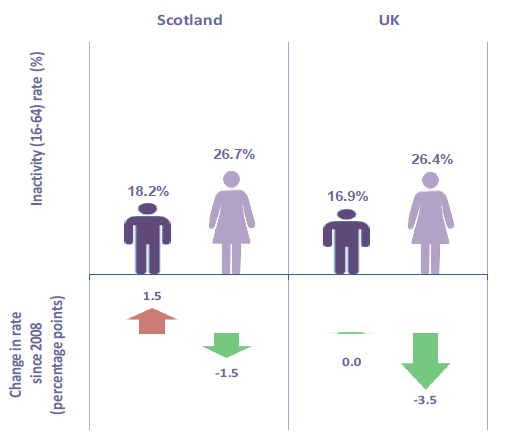
Economic inactivity rates, since 2008, have increased for the younger age bands 16-24 years and decreased for those 50-64 years.
Economic inactivity rates for 25-34 year olds have remained around 15 per cent from 2004 to 2018 while the economic inactivity rates for 35-49 year olds also remained fairly constant, although was slightly higher in 2016 and 2017 than in 2018.
Chart 38: Economic Inactivity Rate (16-64) by age, Scotland
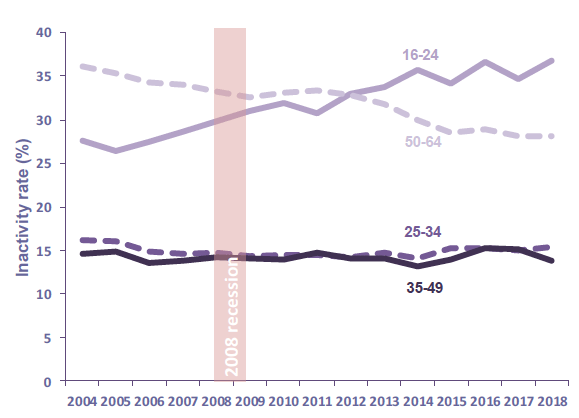
Those aged 16-24 have seen their inactivity rates increase from 29.8 per cent in 2008 to 36.7 per cent in 2018.
In contrast, inactivity rates for those aged 50-64 have generally been decreasing over time (33.2 per cent in 2008 to 28.1 per cent in 2018), highlighting that more people aged 50-64 are moving from being economically inactive to being in employment.
In 2018, around 40 per cent of all inactive were aged 50-64 years. Whereas 27.2 per cent were aged 16-24 years.
Chart 39: Economic Inactivity Rate (16-64) by age and gender, Scotland 2018
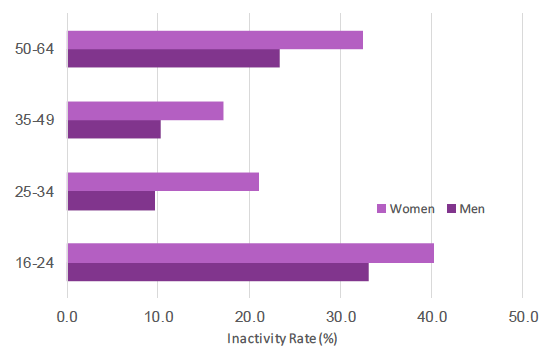
Since 2008, the largest increase in the inactivity rate was in those aged 16-24 years. This increase was slightly greater for men.
The inactivity rate for those aged 25-34 years had also increased slightly in this time period overall. The increase in inactivity in this age band was driven by males where the rate increased by 1.6 percentage, compared with a 0.1 percentage point decrease for women.
For women’s inactivity level and rate has decreased by the greatest amount for those 35-49 years and those 50-64 years.
Chart 40: Economic Inactivity Rate (16-64) by age and gender, percentage point change since 2008, Scotland
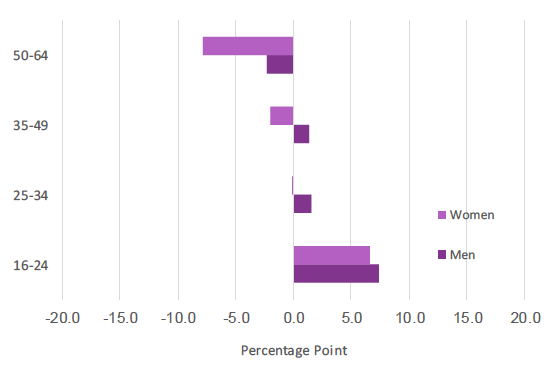
6.3 Reasons for Inactivity
Over 50 per cent of the 777,600 economically inactive people in Scotland were inactive because they were long-term sick or students.
Of the 777,600 economically inactive people (aged 16-64) in 2018, the main reasons for being inactive were long-term sick or disabled (210,600, 27.1 per cent) and student (208,100, 26.8 per cent).
Around one quarter (24.3 per cent) of all inactive aged 16-64 years are in full time education, the majority of whom are aged 16-24 years old.
Chart 41: Reasons for Inactivity, Scotland, 2018
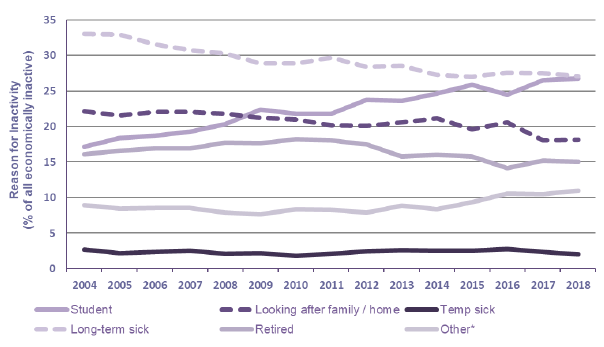
Increase in economic inactivity levels since 2008 was driven by increases in the number of students.
Economic inactivity levels (16-64 years) in Scotland have increased by 13,300 since 2008. This has been driven mainly by a 52,800 increase in the number of students who were inactive as well as those who gave ‘Other’ as the reason for being inactive (up 25,600).
Whereas since 2008 decreases have been in those looking after family or home, decreasing by 25,600, long-term sick or disabled decreasing by 20,700 and retired decreasing by 18,500.
Chart 42: Change in reasons for Inactivity 2008-2018, Scotland
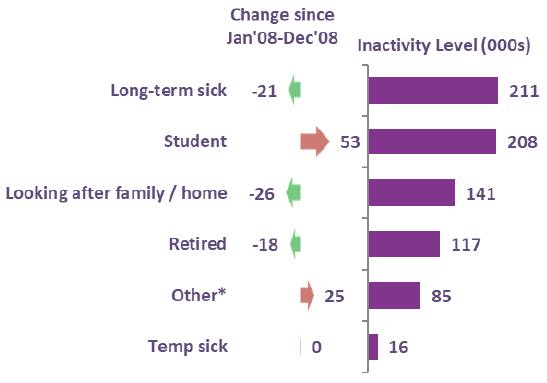
Reasons for inactivity differ by gender with looking after family/home accounting for 6.7 per cent of inactive men and 25.5 per cent of inactive women.
Long-term sick and temporary sick accounted for 36.1 per cent of inactive men and 24.6 per cent of inactive women.
Chart 43: Composition of those aged 16-64 who were economically inactive, Scotland
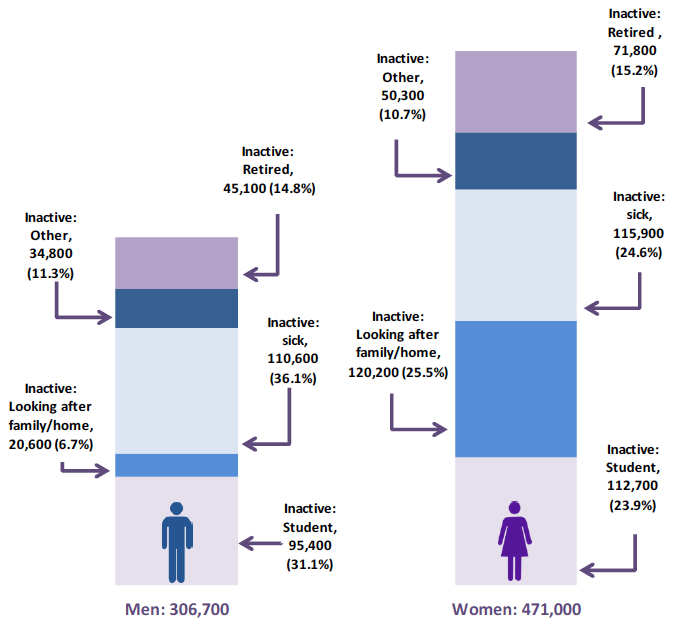
6.4 Local authorities
Economic Inactivity rates were highest in Glasgow, Dundee and South Ayrshire.
There is considerable variation in inactivity rates for those aged 16-64 across Scotland’s local authorities.
In 2018, the highest economic inactivity rates were seen in Glasgow City (31.4 per cent), Dundee City (28.3 per cent) and South Ayrshire (27.6 per cent).
The lowest rates were seen in Aberdeenshire (16.3 per cent), Highland (16.7 per cent) and East Lothian (17.3 per cent).
Since 2017, economic inactivity rates decreased in 14 of the 32 local authority areas while 16 saw an increase in their inactivity rates (there is no data for Orkney and Shetland Islands).
A statistically significant increase between 2017 and 2018 was seen in South Ayrshire (up 4.7 percentage points from 22.9 per cent to 27.6 per cent) and Dumfries and Galloway (up 4.9 percentage points from 21.4 per cent to 26.3 per cent).
Since 2008, economic inactivity rates increased in 17 of the 32 local authority areas while 13 saw a decrease in their inactivity rates.
A statistically significant increase between 2008 and 2018 was seen in Moray (up 5.6 percentage points from 17.3 per cent to 22.9 per cent), Stirling (up 4.6 percentage points from 21.6 per cent to 26.2 per cent), Scottish Borders (up 4.5 percentage points from 18.6 per cent to 23.1 per cent). There was a statistically significant decrease in East Lothian (down 4.6 percentage points from 22.0 per cent to 17.3 per cent).
It should be noted that economic inactivity rates in university cities are likely to be higher due to higher levels of economically inactive students.
Figure 9: Inactivity Rates for 2018 16-64 year olds (per cent)
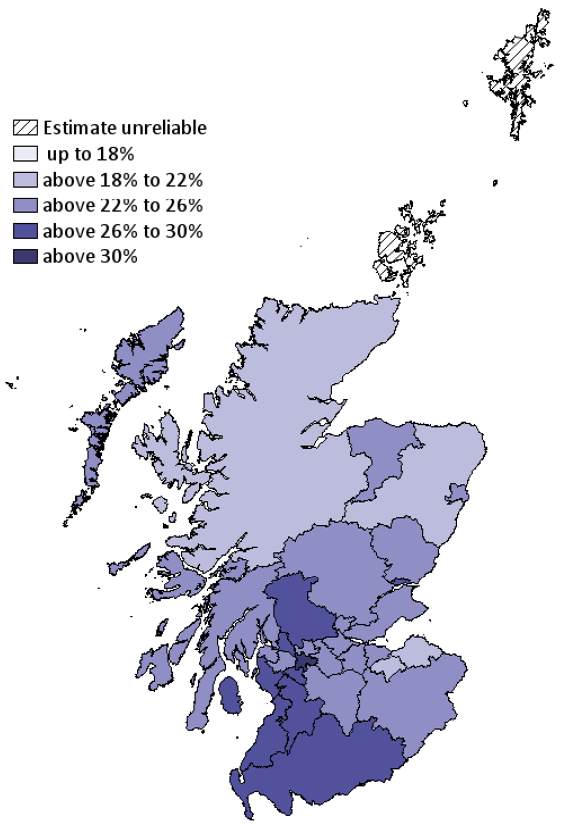
6.5 Want to work
20.9 per cent (162,700) of economically inactive people aged 16-64 in Scotland would like to work but were currently unable to do so, the lowest percentage in the series.
The proportion of those who were economically inactive but who wanted to work has decreased since 2013, having previously been on an upward trend since 2010.
Since 2008, the proportion of those who were economically inactive who would like a job decreased by 3.7 percentage points from 24.7 per cent in 2008 to 20.9 per cent in 2018.
The percentage of economically inactive who would like to work decreased for both males and females. Although is lower for females at 19.9 per cent compared with 22.5 per cent for males.
Regional Differences
In 2018, the local authorities with the highest proportion of economically inactive people who would like to work were Na h-Eileanan Siar (44.6 per cent), West Lothian (31.9 per cent) and West Dunbartonshire (29.8 per cent).
The lowest proportions were seen in East Renfrewshire (15.4 per cent), East Dunbartonshire (15.6 per cent) and Aberdeen City (16.5 per cent).
Chart 44: Proportion of economically inactive people (16-64) who would like a job by gender, 2004-2018, Scotland
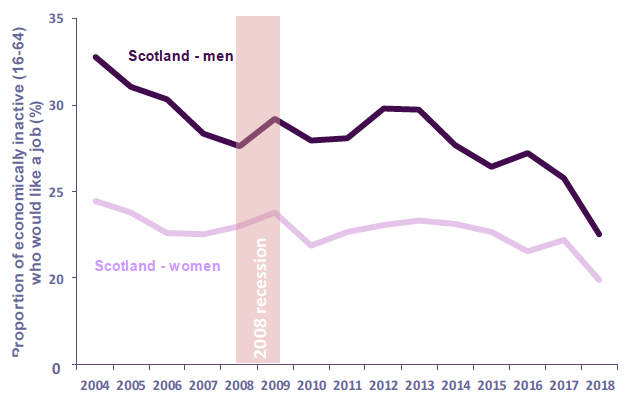
6.6 Never Worked
160,200 people in Scotland in 2018 have never worked (excluding 16-24 year old students in full-time education).
In 2018, 320,300 people in Scotland aged 16 and over have never worked, an increase of 16,700 over the year. Half of the people in Scotland who have never worked were 16-24 year olds in full-time education.
Excluding 16-24 year olds in full-time education, there were 160,200 people in Scotland who have never worked; an increase of 7,000 over the year.
Since 2008, the number of people who have never worked including and excluding 16-24 year old students in full-time education has increased by 85,700 and 52,700, respectively.
Regional Differences
Since 2008, reductions in the number of people who have never worked were seen across 3 local authority areas with 24 seeing increases and one remaining unchanged. No information is available for Clackmannanshire, Na h-Eileanan Siar, Orkney Islands or Shetland Islands.
The largest increases in the number of people who have never worked since 2008 were seen in Glasgow City (up 17,700), Fife (up 10,800) and Aberdeen City (up 8,900).
Chart 45: Number of people who have never worked (16+), 2004-2018, Scotland
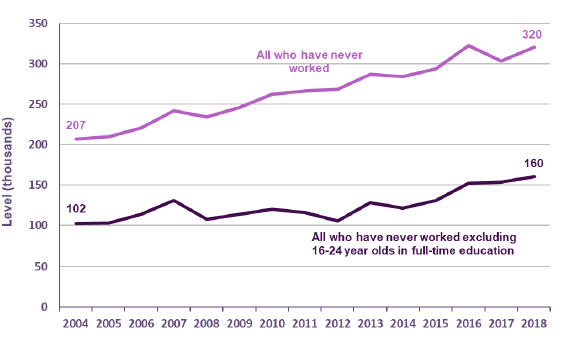
Note: The number of people who have never worked covers those aged 16+ who are currently unemployed or economically inactive.
* other includes discouraged worker
Contact
If you have any enquiries relating to Labour Market Statistics then please contact us at:
Email: LMStats@gov.scot
Telephone: 0131 244 6773
Fax: 0300 244 1060
Post:
Labour Market Statistics
OCEAES: Economic Strategy and Policy
Scottish Government
5th Floor
5 Atlantic Quay
150 Broomielaw
Glasgow
G2 8LU
We welcome any comments on both the format and content of the website, including any problems you may encounter.
You may also contact the Statistician Group Enquiries for general information.
There is a problem
Thanks for your feedback